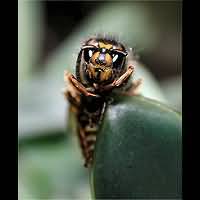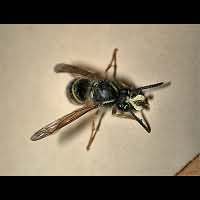[All pictures of garden wildlife on this page are thumbnails. Click on any thumbnail for a large format to be displayed.]
Common Wasp (Vespula vulgaris)
The Common Wasp is black with yellow lines. These lines run straight, but are very variable in size. A rather sure way of identifying most Common Wasps is by looking at the clypeus: it is yellow with a black anchor-shaped marking. In some animals the anchor-shape is reduced. If it has been reduced to three small black dots it is extremely difficult to tell the animals apart from the very similar German Wasp. The Common Wasp is the smaller of the two, but the differences are extremely minuscule. Queens reach a length of 16 to 19mm. The males reach a bodily length of 13 to 17mm. The workers are relatively modest, growing to some 11 to 14mm only.
The queen starts building her nest by the end of April. Usually the nest is made in old animal nests in the ground. But nests are also made in confined spaces above the ground, such as hollow trees and hollow walls. The Common Wasp's paper is made of rather moist, decaying wood. The nest is ochreoous to brownish in color. The outside is rough and covered in clam-shaped air chambers. A nest may contain up to 12 combs and some nests are over 1 meter long. At it's peak a colony may be comprised of over 12,000 animals, eggs and larvae included. A queen is capable of producing 50,000 eggs! The nest is well guarded and the Common Wasp is quite aggressive in it's vicinity. Just like with most other wasps and bees a pheromone is released with each sting, alarming the other wasps in the nest. That is why swarms of bees and wasps attack intruders. By the end of summer this species likes to eat sweet stuff. It readily visits houses and terraces to get at it. It is extremely persistent and will sting if it feels like it. Almost all people that got stung by a Yellow Jacket got stung by either the Common Wasp or the German Wasp. Still these two species have given all wasps a bad name.
The Common Wasp is extremely common in all moderate zones of the Northern hemisphere: Europe, Asia, Japan and Northern America. Has been introduced in New Zealand and Australia. In Britain it and the German Wasp are the most common Yellow Jackets. The big nests often houses one or more guests, such as the larvae of some hover flies.
Lots of orchids do not produce any nectar at all. So they are worthless to the pollinators. Yet they attract certain insects. How do they do that? The orchids produce the so-called pheromons of certain insects. Pheromons are chemical compositions that travel through the air. Among others attracting the opposite sex of certain animals. They smell eachother, often over long distances. The orchids immitate these chemicals, thus attracting the insect. It will enter the flower, believing there should be a mate somewehere. After looking for quite some time, it will leave the flower disappointed. Only to be attracted by the next flower of course. While visiting the first flower, it glues a horn like lump of seed on the forhead of the insect. In the next flower this lump is taken off and thus the orchid is reproducing itself. In our part of Europe most orchids concentrate on wasps, but there are also orchids fooling flies or beetles. Besides a picture of a wasp having such a hornlike lump attached to its head.
The queen starts building her nest by the end of April. Usually the nest is made in old animal nests in the ground. But nests are also made in confined spaces above the ground, such as hollow trees and hollow walls. The Common Wasp's paper is made of rather moist, decaying wood. The nest is ochreoous to brownish in color. The outside is rough and covered in clam-shaped air chambers. A nest may contain up to 12 combs and some nests are over 1 meter long. At it's peak a colony may be comprised of over 12,000 animals, eggs and larvae included. A queen is capable of producing 50,000 eggs! The nest is well guarded and the Common Wasp is quite aggressive in it's vicinity. Just like with most other wasps and bees a pheromone is released with each sting, alarming the other wasps in the nest. That is why swarms of bees and wasps attack intruders. By the end of summer this species likes to eat sweet stuff. It readily visits houses and terraces to get at it. It is extremely persistent and will sting if it feels like it. Almost all people that got stung by a Yellow Jacket got stung by either the Common Wasp or the German Wasp. Still these two species have given all wasps a bad name.
The Common Wasp is extremely common in all moderate zones of the Northern hemisphere: Europe, Asia, Japan and Northern America. Has been introduced in New Zealand and Australia. In Britain it and the German Wasp are the most common Yellow Jackets. The big nests often houses one or more guests, such as the larvae of some hover flies.
Lots of orchids do not produce any nectar at all. So they are worthless to the pollinators. Yet they attract certain insects. How do they do that? The orchids produce the so-called pheromons of certain insects. Pheromons are chemical compositions that travel through the air. Among others attracting the opposite sex of certain animals. They smell eachother, often over long distances. The orchids immitate these chemicals, thus attracting the insect. It will enter the flower, believing there should be a mate somewehere. After looking for quite some time, it will leave the flower disappointed. Only to be attracted by the next flower of course. While visiting the first flower, it glues a horn like lump of seed on the forhead of the insect. In the next flower this lump is taken off and thus the orchid is reproducing itself. In our part of Europe most orchids concentrate on wasps, but there are also orchids fooling flies or beetles. Besides a picture of a wasp having such a hornlike lump attached to its head.

© Copyright 1998-2024 gardensafari.net (Hania Berdys)

 English / engels
English / engels  Dutch / nederlands
Dutch / nederlands



